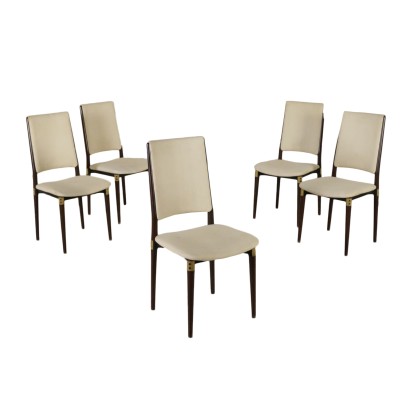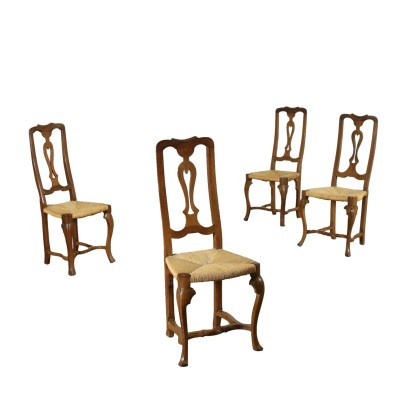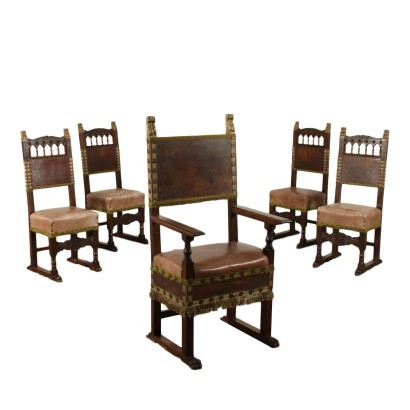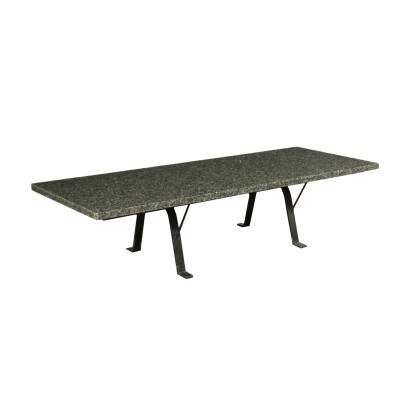Chairs by Eugenio Gerli - Tecno Production
Features
Designer: Eugenio Gerli
Production: Tecno
Time: 1960s , 1970s
Production country: Varedo, Lombardia, Italy
Main essence: Mahogany
Material: Foam , Metal , Brass , Fabric
Description
A group of five chairs designed by Eugenio Gerli (1923) for Tecno. Mahogany, metal, brass, foam padding, fabric upholstery. Manufactured in Varedo, Italy, 1960s-1970s.
Product Condition:
Good condition. Wear consistent with age and use. Any damage or loss is displayed as completely as possible in the pictures.
Dimensions (cm):
Height: 94
Width: 46
Depth: 55
Seat height: 44
Additional Information
Designer: Eugenio Gerli
Eugenio Gerli was born in 1923, in Milan. Architect and designer, he graduated from the Milan Polytechnic in 1949 and since 1950 he has dedicated himself to the activity of architect dividing himself professionally between Italy and Europe, the United States, the Middle East and the Ivory Coast. Active in the early evolutionary stages of Italian industrial design, as early as 1947 he experimented with alternative materials such as plywood and plastic felt. Beginning in 1957, a close collaboration with Tecno, participates in the growth of the company by designing some of the most successful products such as the Graphis program (which has revolutionized the way of conceiving the operational office), Graphis Box and the Clamis chairs.
Production: Tecno
Tecno spa, fondata nel 1953 da Osvaldo e Fulgenzio Borsani, è un'azienda industriale con centri di produzione in Italia e all'estero, che può contare sul supporto di una rete internazionale di succursali e rivenditori. Il marchio Tecno identifica una compagnia che possiede ancora l'entusiasmo iniziale per l'ingegneria e l'innovazione tecnologica e che continua a considerare essenziale la qualità del design, dei materiali e dell'artigianalità, permettendo così ai propri prodotti di vincere le sfide imposte dal futuro. I primi prodotti Tecno presentati sulla scena europea del design sono stati il divano D70 e le poltrone reclinabili P40, entrambi disegnati da Osvaldo Borsani rispettivamente nel 1954 e nel 1955. Due classici Tecno rimangono il sistema operativo Graphis (disegnato da Osvaldo Borsani e da Eugenio Gerli e presentato nel 1968 alla Triennale di Milano), che ha segnato una svolta nel mercato del mobile per l'ufficio, e le sedute Modus, lanciate nel 1972. In oltre cinquant'9anni di esperienza, Tecno ha messo a punto un sistema di comunicazione diretta con i clienti, gli architetti e i facility managers per garantire servizi e prodotti dal brief iniziale fino alla loro installazione. La vera rivoluzione di Tecno è data dal proporsi come azienda di progetto più che di prodotto. Con i progetti tailor made, tra i quali ricordiamo il rinnovato British Museum dell'architetto Norman Foster, la realizzazione della torre Agbar a Barcellona, progettata da Jean Nouvel, ed il Parlamento Europeo di Bruxelles, Tecno è in grado di superare la rigidità strutturale di uno specifico prodotto, per andare incontro alle esigenze del committente, che sia un'azienda o un progettista. Ed è in virtù di un rapporto privilegiato con il mondo dell'architettura che Tecno può vantare un curriculum di realizzazioni firmate da architetti noti in tutto il mondo tra cui Gae Aulenti, Emilio Ambasz, Ricardo Bofil, Norman Foster, Piero Lissoni, Rafael Moneo, Jean Nouvel, Renzo Piano, Sir Richard Rogers, Luca Scacchetti, Jean Michael Wilmotte e tanti altri. Molti dei prodotti Tecno sono oggi esposti presso alcuni dei maggiori musei del mondo: il MOMA (New York e San Francisco), il Victoria and Albert Museum (Londra), il Centre Georges Pompidou (Parigi), la Neue Sammlung (Monaco), il Musée des Arts Décoratifs (Montreal) e la Triennale di Milano. Time:
1960s
1960s
1970s
1970s
Main essence: Mahogany
It is one of the most precious and sought-after woods in cabinet making. It was discovered in Central America around 1600 and began to be imported to England in the 1700s. Much appreciated for its hardness and indestructibility, it became widespread following the blocking of walnut exports from France in 1720 and the consequent elimination of English import duties on mahogany from the colonies in America and India. The most valuable version comes from Cuba, but it became very expensive. At the end of the 18th century it began to be used also in France in Louis XVI, Directory and Empire furniture, its diffusion declined starting from when Napoleon, in 1810, forbade its import. It was generally used in the manufacture of elegant furniture, due to its characteristics and beautiful grain. Material:
Foam
Metal
Brass
Fabric






























